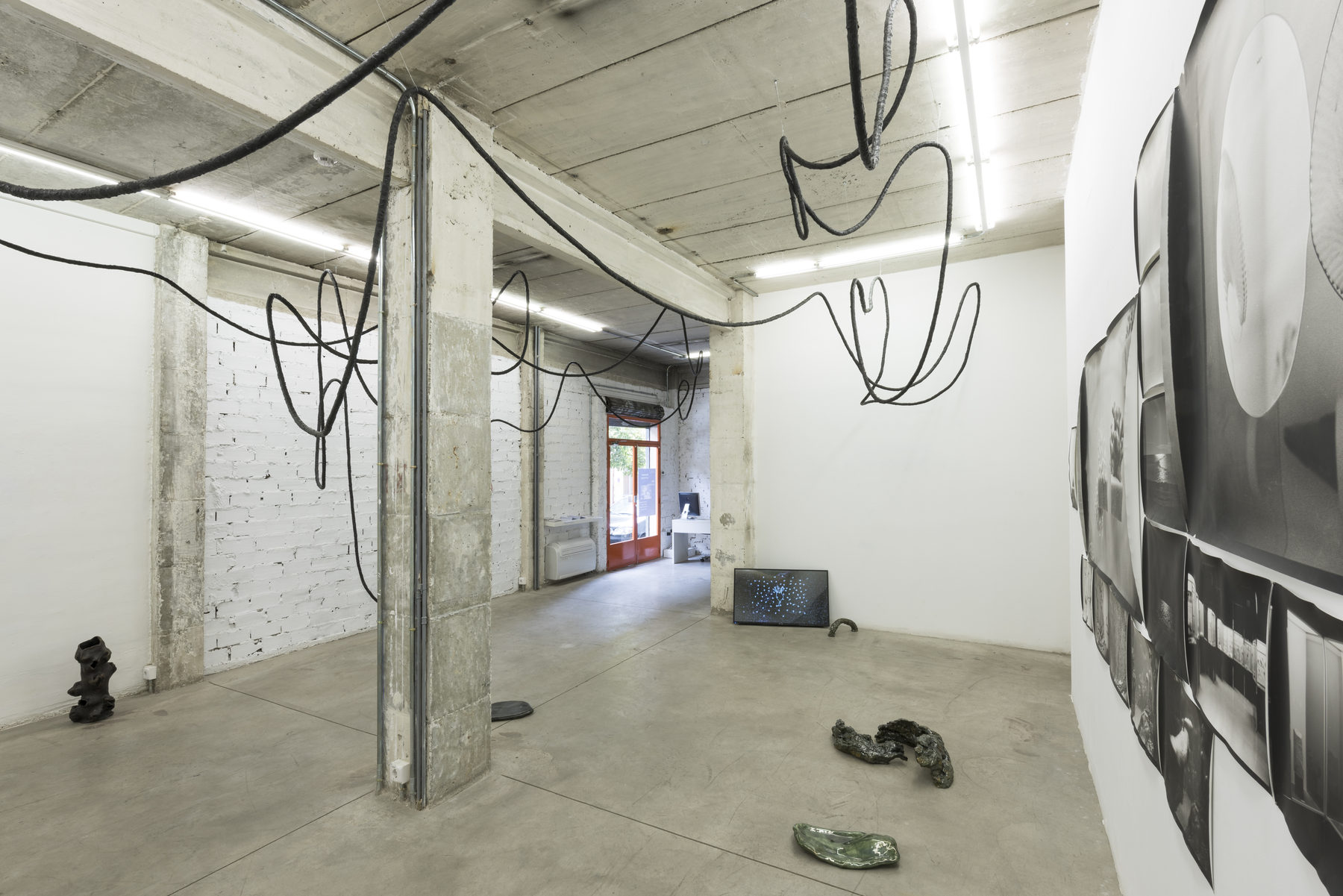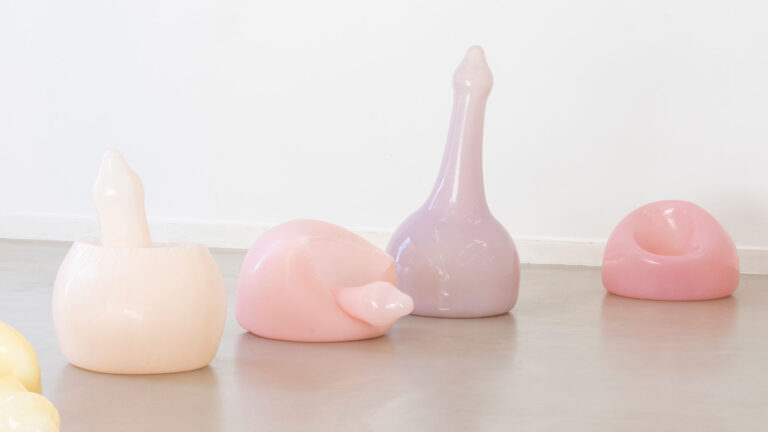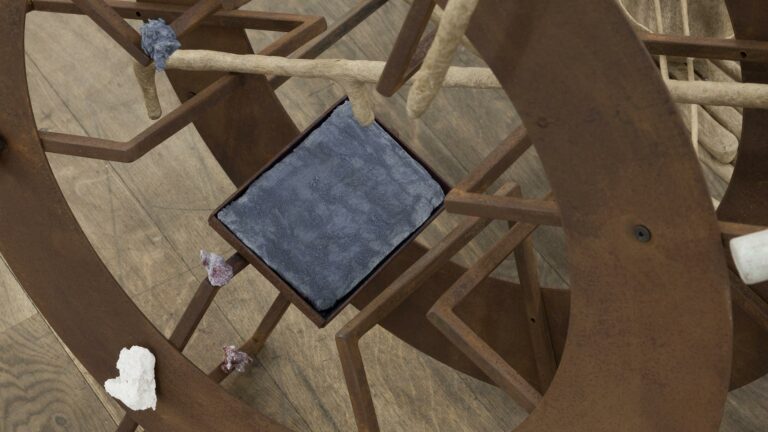Artists: Salvatore Arancio, Olivier Castel, Petra Feriancová, Iza Tarasewicz
Exhibition title: Mushrooms on the ruins
Curated by: Borbála Soós
Venue: Nogueras Blanchard, Madrid, Spain
Date: May 27 – July 22, 2017
Photography: Roberto Ruiz, all images copyright and courtesy of the artist and Nogueras Blanchard, Madrid
NoguerasBlanchard is delighted to present Mushrooms on the Ruins, an exhibition curated by Borbala Soos that was selected for the sixth edition of the curatorial Open Call organized by the gallery.
How do forests think? Do plants communicate? What are animals dreaming about? Humans live in the entangled connections of a complex system created by other beings. Perhaps it is not a coincidence that in children’s tales mushrooms are often called little men in hats. Anthropomorphising plants, or thinking about subjects that are interchangeable are symptoms of a search for familiar features and abilities, in our attempt to understand them.
The relationship between fungi and humans, including the stories that they unfold, can be used as metaphors for our future survival. As Anna Lowenhaupt Tsing put it, it is time to pay attention to mushroom picking, not that it can save us – but it might open our imagination when we are stuck with the problem of living despite economic and ecological ruination.
In the 1963 Japanese horror film ‘Matango’ (aka ‘Attack of the Mushroom People’) directed by Ishirō Honda, a group of people turns into mushrooms on a mysterious deserted island*. We meet a small company of friends of various professions and social status, who leave behind their modern city lives in Tokyo to go sailing. They become wrecked on a deserted island, with no other visible human activity apart from a second abandoned and marooned ship, which the characters determine was a nuclear research vessel. This ship is overtaken by mushrooms – the only edible species growing in abundance on the island. In the film the fungi are dangerous: they cause hallucinations and drive people insane, but most importantly, consuming them means that people are slowly transformed into mushrooms or a new fungi-human-hybrid species. The characters are consuming and being consumed, and eventually become inseparable from the island and its landscape. Only a single person manages to return to Japan, where he tells his tale, albeit from a psychiatric ward. Summing up his experiences, he points out that the booming and cruel city of Tokyo is not that different from this other island.
Anna Lowenhaupt Tsing in her book ‘The Mushroom at the End of the World, On the Possibilities of Life in Capitalist Ruins’ writes about entangled connections involving people and mushrooms. We find stories about forests where the curious autumn-smelling matsutake mushrooms thrive on land that suffered from human disturbances. After the destruction of the atom bomb on the city of Hiroshima, the first thing to grow in the charred and blasted landscape was matsutake. These fungi now present all over the world exchange for a high-price, which provides opportunities for displaced and disempowered people to find work and carve out a new living.
The exhibition maps relations between various species in a landscape both strange and familiar. It strives to open up a world of imagination where all other beings have the same agency as humans, and where, if you wish, species are capable or becoming, or transforming into one another.
What we share with mushrooms, or other living things – whether bacterial, floral, fungal or animal – is that how we represent the world around us, is in some way or another constitutive of our beings**. We are inseparable from our companion species, and dependent on them for our survival. It is an illusion that we can detach ourselves, and keep only within the borders of our bodies, or retreat within the walls of our cities. Instead, what we can do, is to redefine ourselves with adaptable and soft boundaries. We can start to understand our evolution as a story of an ongoing cross-contamination, and our bodies as a site of nature in the past, present and future.
As social beings as well as economic and ecological factors, we are inseparable from the world around us, and as such, our fate is bound to other living creatures.
Thinking about a future landscape, on the ruins of capitalism, we can envision a new type of structure. Humans might soon disappear and leave behind a blasted and disturbed landscape – one, however, fertile for mushrooms like matsutake to dominate. These fungi will choose and enable other types of trees and forests to grow as their companions, and hence aid new landscapes to emerge. Human activity, or more precisely, the memory of human beings will be transformed into mushrooms, and then plants and other new species.
* Hybrid species are not new to the Ishiro Honda, he also directed the first Godzilla movies in 1954 and 1956.
** Eduardo Kohn: How Forests Think, Towards an Anthology beyond the Human, 2013. Kohn has a complex theory and explanation about what he means by representation here. Semiosis (the creation and interpretation of signs) permeates and constitutes the living world, and it is through our partially shared semiotic propensities that multi- species relations are possible, and also analytically comprehensive.
With thanks to the galleries Kunstraum, London; Croy Nielsen, Vienna; Federica Schiavo, Milan; BWA Warszawa, Warsaw.
Mushrooms on the ruins, 2017, exhibition view, Nogueras Blanchard, Madrid
Mushrooms on the ruins, 2017, exhibition view, Nogueras Blanchard, Madrid
Mushrooms on the ruins, 2017, exhibition view, Nogueras Blanchard, Madrid
Mushrooms on the ruins, 2017, exhibition view, Nogueras Blanchard, Madrid
Mushrooms on the ruins, 2017, exhibition view, Nogueras Blanchard, Madrid
Mushrooms on the ruins, 2017, exhibition view, Nogueras Blanchard, Madrid
Mushrooms on the ruins, 2017, exhibition view, Nogueras Blanchard, Madrid
Mushrooms on the ruins, 2017, exhibition view, Nogueras Blanchard, Madrid
Mushrooms on the ruins, 2017, exhibition view, Nogueras Blanchard, Madrid
Mushrooms on the ruins, 2017, exhibition view, Nogueras Blanchard, Madrid
Salvatore Arancio, Glue Pour I, 2015
Salvatore Arancio, FDBT 5 (Cracks), 2015
Petra Feriancová, Untitled, 2017
Salvatore Arancio, BF39 Stamm, 2014
Salvatore Arancio, When the Same Organ is Rigorously Compared in Many Individuals, I Always Find Some Slight Variability, 2016
Petra Feriancová, Porífera, 2017
Iza Tarasewicz, Arena I, 2013-2014
Iza Tarasewicz, Arena II, 2013-2014
Petra Feriancová, Fungi, 2017
Petra Feriancová, Fungi, 2017
Petra Feriancová, Mushrooms on the Ruins, 2017
Olivier Castel, Book of Animals’ Times, 2017
Olivier Castel, Book of Animals’ Times, 2017





























